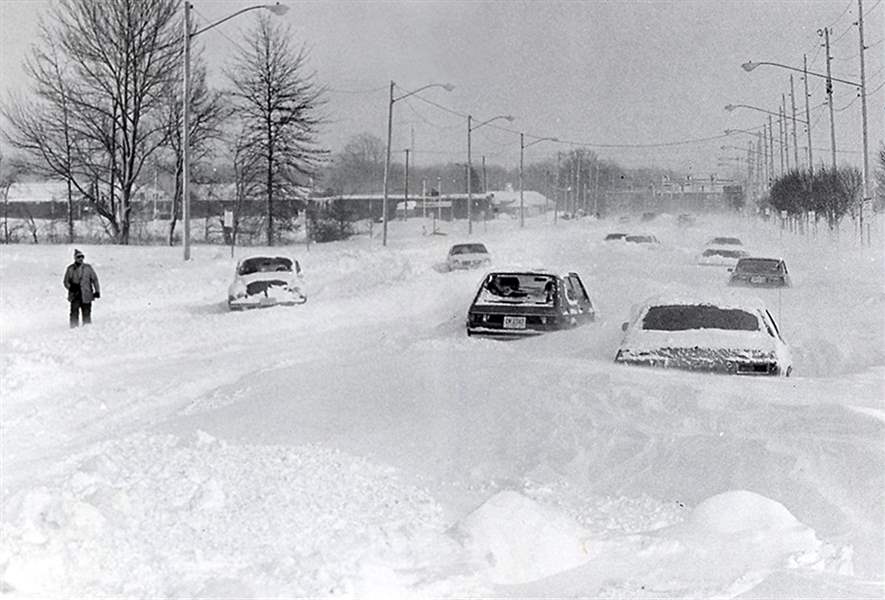
Blizzard’s bite reminiscent of deadly 1978 storm event
1/6/2014
Cars are stranded on Heatherdowns Boulevard on Jan. 27, 1978, after the big blizzard. Some drifts measured up to 15 feet.

Cars are stranded on Heatherdowns Boulevard on Jan. 27, 1978, after the big blizzard. Some drifts measured up to 15 feet.
At the risk of sounding like an old geezer, there are snowstorms, there are winter weather events, and there is the Blizzard of 1978. For anyone 45 years old or older, that seems to be the standard for cataclysmic winter storms. Anything less is just that — less.

Since the current winter decided a few days ago to grow some fangs and once again show us who is boss, it seems like an appropriate time to recall the nasty disposition of the 1978 storm. It was so bad that it had some of the more creative middle-age males pushing to rename our weather maker “Mother-in-law Nature.”
Until this recent run of really mean cold, wind, and snow, the only blizzard many young folks knew is Blizzard Bill Spencer, the boutonnière wearing meteorologist at WTVG Channel 13. If he received that chilly moniker in the winter of ’78, then he certainly earned it.
My experience with the Blizzard of ’78 was unique, but not out of the ordinary. This storm caught everyone off guard, combining heavy snow with brutal cold and battering us with near-hurricane force winds.
On the afternoon of Wednesday, Jan. 25, 1978, I drove to South Bend to see a basketball game between Notre Dame and West Virginia. My college buddy Mark Dominik and I took about 2½ hours to get there, and a little more than three days to get back. We met the Blizzard of ’78 on the return trip.
It was barely snowing when we arrived at the arena, but by the time the game ended the snow was intense, and the Indiana Turnpike had just one lane open with traffic moving about 45 miles per hour. The wind picked up, the snow was relentless, and when we hit the Ohio line, we were turned back and told the turnpike was closed because of numerous crashes and treacherous conditions.
We reversed course, going the wrong way up the entrance ramp and found a small mom-and-pop, 20-unit motel near the top of the hill. We checked in and hunkered down, expecting things would clear by morning. At 8 a.m. the snow was even with the door handle, and that was not a drift. The wind howled, and the temperature was around zero.
The proprietor called and said he would carve a path from each room to the adjoining restaurant and serve a family style breakfast to his motel guests about 9:30. For the next two days we ate our meals with the truckers, travelers, and other stranded motorists, read the Gideon’s Bible and the Book of Mormon front to back, and watched far too many soap operas and episodes of Gilligan’s Island.
When word came that the road to the turnpike had finally been cleared, we set out for home. The Ohio Turnpike was one lane that drove like a back country two-track, because of large hunks of ice and compacted snow. All traffic was escorted by a highway patrolman, acting as the pace car, at a bumpy 30 miles an hour.
The scene along the turnpike was something out of The Day After Tomorrow — dozens of abandoned vehicles, some upside down, some face-planted in the huge drifts. We learned later that 70 people had died in the storm, and more than 20 of them perished while trying to walk for help after their vehicles had become stuck in the snow.
The most vivid aspect of the blizzard’s calling card was a torn, twisted, and flipped livestock hauler that had apparently careened out of control in the storm. Several dead steers lay in the median, legs outstretched, eyes open, but frozen stiff. It was something from a Salvador Dali sketch pad.
In the days and weeks after the storm, I learned more about how it had paralyzed nearly everything and everyone. Back home, the police had to come to pick up my dad on a snowmobile so he could get to the hospital to deliver a baby. Other folks still needed surgery or to see the doctor, regardless of the dreadful weather.
The National Guard played a heroic role during the worst of the storm and in its aftermath. They used bulldozers and backhoes to help pull some of the more than 1,000 abandoned vehicles from drifts that measured up to 15 feet deep. Guard helicopters flew close to 3,000 missions in Ohio, ferrying doctors and nurses and medical supplies and air-dropping feed to stranded livestock.
This storm hit before we had cell phones, and many people had to survive for several days without heat, water, electricity, or telephone service. Some schools were closed for a week or longer. With so many streets, roads, and highways buried in deep drifts, we were essentially frozen.
Ohio lost a lot in that storm, including 90 percent of our quail population. In the 35 years since that blockbuster blizzard, the quail population has made little recovery, hindered further by dwindling habitat.
Avian experts also lamented the storm’s impact on the Ohio population of Berwick’s wren, which was believed to have been wiped out in that notorious weather pattern. The Carolina wren and the northern mockingbird were nearly eradicated by the sustained brutality of the blizzard.
Today we benefit from much better weather forecasting technology, which provides us with ample time to prepare for storms such as this current winter hellion, and much more precise information as to the duration and severity of such events.
But dealing with nature’s fury has changed little. We still stock up on the essentials, keep the fireplace roaring, and stay off the drift-choked roadways until the storm relents. And we still have no control over when that takes place.
Contact Blade outdoors editor Matt Markey at: mmarkey@theblade.com or 419-724-6068.